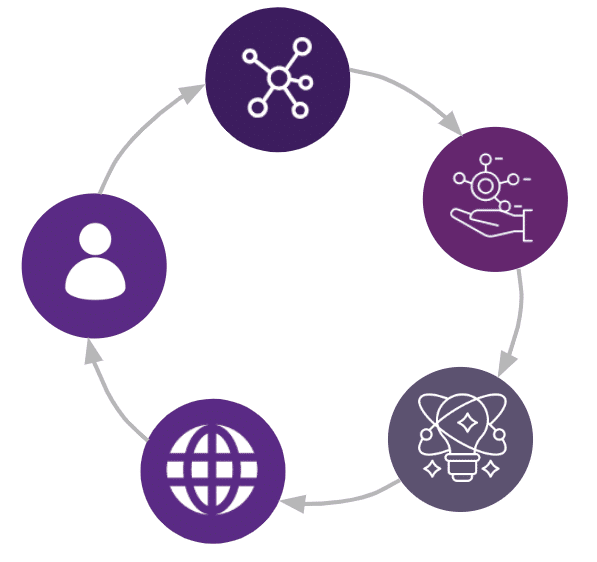In today’s digital landscape, where content overload is a constant challenge, recommendation engines (also known as personalized content recommenders, or just “recommenders”) have emerged as powerful solutions that help users cut through the noise and discover relevant information. These intelligent tools enhance user experiences by surfacing personalized recommendations based on user activity or specific input selections at the point of need. While people may be most familiar with recommendation engines utilized by the likes of Amazon and Netflix, recommendation engines have been successfully implemented in various domains beyond big tech. Businesses can utilize internal recommendation engines to streamline knowledge management processes, ensuring employees have access to the most relevant resources and expertise within the organization.
Traditional Approach vs. Semantic Approach
There are two mainstream frameworks for developing a recommendation engine: traditional recommendation engines and semantic recommendation engines. It is important to select the right framework based on your use case, scale and availability of data, and internal resources.
Traditional recommender approaches involve leveraging user analytics to establish statistical associations between content and user interests. However, these approaches come with challenges such as the “cold start” problem, arising from a lack of historical user data when a recommender is initialized, making it challenging to provide accurate and tailored recommendations from the outset. Additionally, these approaches rely heavily on machine learning resources and subject matter expertise, further adding to the complexity and investment required in building and maintaining such systems.
In contrast, the semantic recommender approach focuses on constructing a finite-scale semantic model and leveraging its capabilities to recommend desired content. This approach has several advantages, including the ability to work with better scoped data sets and to utilize an organization’s existing taxonomies and metadata as contextual information for machine learning algorithms. With less emphasis on machine learning expertise and a faster development time, the semantic recommender approach provides a practical and efficient solution to building recommenders that meet immediate business needs.
Establishing a Semantic Recommendation Engine
When using a semantic approach, the process of building the recommendation engine should be specifically tailored to capitalize on the advantages of these solutions. EK has been successful using the following 5 iterative steps to launch production grade semantic recommendation engines and applications to help businesses make targeted recommendations and improve their content personalization journey.
1. Define the Use Cases
 When building a semantic recommendation engine, clearly defining the use cases is crucial for successful implementation. This involves identifying the corresponding personas, problem statement, and the necessary inputs and outputs. To initiate recommendations, the system requires trigger inputs, typically consisting of 1-3 user-provided inputs that serve as the basis for generating recommendations. Having known information about the trigger inputs provides a starting place and can facilitate the recommendation process by narrowing down the scope and improving the relevance of the suggestions.
When building a semantic recommendation engine, clearly defining the use cases is crucial for successful implementation. This involves identifying the corresponding personas, problem statement, and the necessary inputs and outputs. To initiate recommendations, the system requires trigger inputs, typically consisting of 1-3 user-provided inputs that serve as the basis for generating recommendations. Having known information about the trigger inputs provides a starting place and can facilitate the recommendation process by narrowing down the scope and improving the relevance of the suggestions.
For example, one of our healthcare provider clients had a semantic recommendation engine use case for enabling clinicians to search for content related to illnesses based on patient information, so that they can pass on that content to patients and assist them in treatment and recovery. The inputs in this case would be the patient information and diagnosis, and the outputs would be content related to those inputs.
The main output of the recommendation engine should provide the minimum information required for users to understand what the recommender offers and to make an informed decision based on the presented information. Alongside the main output, having known information about the recommendations can provide additional context and details to enhance the user experience or help to validate the results. By carefully defining the use case and considering these elements, businesses will effectively plan to generate meaningful and relevant recommendations for users.
2. Create Supporting Data Models
 Once the use case has been defined, the next step in building a semantic recommendation engine is to create supporting data models, including taxonomies and ontologies. Taxonomies establish hierarchical structures and relationships between various content items, enabling efficient content classification based on shared characteristics. On the other hand, ontologies define the complex relationships and dependencies between different entities, attributes, and concepts, fostering a deeper understanding of the data. By leveraging these relationship-based structures, the semantic recommendation engine can provide more contextually relevant and personalized suggestions.
Once the use case has been defined, the next step in building a semantic recommendation engine is to create supporting data models, including taxonomies and ontologies. Taxonomies establish hierarchical structures and relationships between various content items, enabling efficient content classification based on shared characteristics. On the other hand, ontologies define the complex relationships and dependencies between different entities, attributes, and concepts, fostering a deeper understanding of the data. By leveraging these relationship-based structures, the semantic recommendation engine can provide more contextually relevant and personalized suggestions.
To effectively design ontologies and supporting taxonomies for the selected use case, an iterative approach is crucial. This involves strategically designing the models to capture the shared characteristics between different content types. During the design process, the models are refined to ensure accurate representation of the relationships and connections between different data elements. Shared metadata can then be incorporated into the ontologies, enriching the content with valuable context and enabling the engine to make more informed recommendations based on those shared metadata. In our healthcare provider example, shared metadata such as content type, content keywords, publication date, and author information could be used to provide context to medical content and improve the relevancy of content recommendations.
3. Construct the Graph
 After creating the supporting data models, the next step in building a semantic recommendation engine is to construct the graph. The graph acts as a database of nodes and connections between nodes (called edges) that houses all of the content relationships defined in the ontology model.
After creating the supporting data models, the next step in building a semantic recommendation engine is to construct the graph. The graph acts as a database of nodes and connections between nodes (called edges) that houses all of the content relationships defined in the ontology model.
Building the graph involves both ingesting and enriching source data. Ingestion maps raw data to nodes and edges in the graph. Enrichment appends additional attributes, tags, and metadata to enhance the data. This enriched data is then be transformed into semantic triples, which are subject-predicate-object structures that capture relationships. In our example, the healthcare provider could transform their enriched data into triples that capture the relationships between diagnoses and medical subjects, and medical subjects and content.
Converting data into a web of semantic triples and loading it into the graph enables efficient querying. The knowledge graph’s flexibility also enables continuous integration of new data to keep recommendations relevant. This means the healthcare provider can query their graph to find medical content that relates to specific diagnoses, and they can continue to add content to their graph database without affecting the existing content, or changing the schema by which they have to run queries.
4. Define and Apply Recommendation Logic
 Once the graph is constructed, the next step in building a semantic recommendation engine is to define and apply the logic for generating recommendations. This involves selecting an appropriate approach – either deterministic or statistical – and implementing the corresponding recommendation logic.
Once the graph is constructed, the next step in building a semantic recommendation engine is to define and apply the logic for generating recommendations. This involves selecting an appropriate approach – either deterministic or statistical – and implementing the corresponding recommendation logic.
In the deterministic approach, various techniques such as path finding, matching, and scoring logic are used to leverage the metadata embedded within the graph to generate recommendations. An example of this approach is content-based recommendation, where recommendations are generated based on the similarity of content attributes.
On the other hand, the statistical approach utilizes graph neural networks or classifiers. These models leverage the power of graph-based machine learning algorithms to determine the probability of matches through weighting algorithms. An example of this approach is link prediction recommendation, where the likelihood of connections between items is predicted based on their graph structure.
By defining and implementing the appropriate logic, the semantic recommendation engine can effectively generate recommendations that align with user preferences and maximize their relevance and utility. Our example healthcare provider may choose a deterministic recommendation approach if they decide they want to provide the content recommendations based on how similar content metadata is to the clinician-provided inputs.
5. Integrate with Enterprise Systems/Applications
 Integration with enterprise systems enables users to interact with the graph through various channels such as a custom web application, an analytics tool, or a machine learning pipeline, through use cases including semantic search and chatbots. By integrating the semantic recommendation engine into enterprise systems, businesses can scale existing data models to multiple use cases and provide users with enhanced experiences, facilitate knowledge discovery, and promote streamlined knowledge management processes.
Integration with enterprise systems enables users to interact with the graph through various channels such as a custom web application, an analytics tool, or a machine learning pipeline, through use cases including semantic search and chatbots. By integrating the semantic recommendation engine into enterprise systems, businesses can scale existing data models to multiple use cases and provide users with enhanced experiences, facilitate knowledge discovery, and promote streamlined knowledge management processes.
For example, the healthcare provider is able to integrate the recommendation engine on the backend with their internal database of content and on the frontend with their clinician portal to let clinicians search for and receive content recommendations in their browser, without having to manually look through their database.
Conclusion
Ultimately, semantic recommendation engines have emerged as essential tools in the digital era, offering personalized content discovery and driving user engagement. Leveraging relationship-based data models, these engines provide contextual suggestions without relying on large volumes of usage data.
To implement an impactful semantic recommendation engine with these 5 steps, key factors include:
- Building the case for the importance of graph-based recommendations
- Acquiring the necessary tooling and architecture
- Establishing and training key roles like data engineers, semantic engineers, and architects
By considering these elements, businesses can efficiently build semantic recommenders that empower them to reap the benefits in navigating today’s data-saturated landscape.
Does your organization need support building your recommender toolkit for success? Contact us at info@enterprise-knowledge.com.

